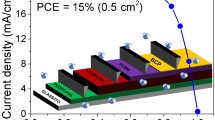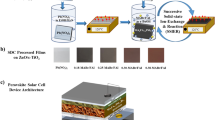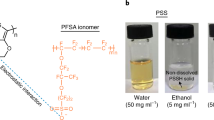Abstract
Organic-inorganic hybrid perovskite solar cells have generated wide interest due to the rapid development of their photovoltaic conversion efficiencies. However, the majority of the reported devices have been fabricated via spin coating with a device area of < 1 cm2. In this study, we fabricated a wide-bandgap formamidinium lead bromide (FAPbBr3) film using a cost-effective, high-yielding doctor-blade-coating process. The effects of different surfactants, such as 1-α-phosphatidylcholine, polyoxyethylene sorbitan monooleate, sodium lauryl sulfonate, and hexadecyl trimethyl ammonium bromide, were studied during the printing process. Accompanying the optimization of the blading temperature, crystal sizes of over 10 µm and large-area perovskite films of 5 cm × 5 cm were obtained using this method. The printed FAPbBr3 solar cells exhibited a short-circuit current density of 8.22 mA/cm2, an open-circuit voltage of 1.175 V, and an efficiency of 7.29%. Subsequently, we replaced the gold with silver nanowires as the top electrode to prepare a semitransparent perovskite solar cell with an average transmittance (400–800 nm) of 25.42%, achieving a high-power efficiency of 5.11%. This study demonstrates efficient doctor-blading printing for preparing large-area FAPbBr3 films that possess high potential for applications in building integrated photovoltaics.

Similar content being viewed by others
References
Jelle B P, Breivik C. State-of-the-art building integrated photovoltaics. Energy Procedia, 2012, 20: 68–77
Dou Y, Liu Z, Wu Z, Liu Y, Li J, Leng C, Fang D, Liang G, Xiao J, Li W, Wei X, Huang F, Cheng Y B, Zhong J. Self-augmented ion blocking of sandwiched 2D/1D/2D electrode for solution processed high efficiency semitransparent perovskite solar cell. Nano Energy, 2020, 71: 104567
Tai Q, Yan F. Emerging semitransparent solar cells: materials and device design. Advanced Materials, 2017, 29(34): 1700192
Bu T, Li J, Zheng F, Chen W, Wen X, Ku Z, Peng Y, Zhong J, Cheng Y B, Huang F. Universal passivation strategy to slot-die printed SnO2 for hysteresis-free efficient flexible perovskite solar module. Nature Communications, 2018, 9(1): 4609
Bu T, Liu X, Zhou Y, Yi J, Huang X, Luo L, Xiao J, Ku Z, Peng Y, Huang F, Cheng Y B, Zhong J. A novel quadruple-cation absorber for universal hysteresis elimination for high efficiency and stable perovskite solar cells. Energy & Environmental Science, 2017, 10 (12): 2509–2515
Yang W S, Park B W, Jung E H, Jeon N J, Kim Y C, Lee D U, Shin S S, Seo J, Kim E K, Noh J H, Seok S I. Iodide management in formamidinium-lead-halide-based perovskite layers for efficient solar cells. Science, 2017, 356(6345): 1376–1379
Bu T, Wu L, Liu X, Yang X, Zhou P, Yu X, Qin T, Shi J, Wang S, Li S, Ku Z, Peng Y, Huang F, Meng Q, Cheng Y B, Zhong J. Synergic interface optimization with green solvent engineering in mixed perovskite solar cells. Advanced Energy Materials, 2017, 7(20): 1700576
NREL Chart. Best research-cell efficiencies. 2020
Zhang Y, Liang Y, Wang Y, Guo F, Sun L, Xu D. Planar FAPbBr3 solar cells with power conversion efficiency above 10%. ACS Energy Letters, 2018, 3(8): 1808–1814
Barrows A T, Pearson A J, Kwak C K, Dunbar A D F, Buckley A R, Lidzey D G. Efficient planar heterojunction mixed-halide perovskite solar cells deposited via spray-deposition. Energy & Environmental Science, 2014, 7(9): 2944–2950
Ye F, Chen H, Xie F, Tang W, Yin M, He J, Bi E, Wang Y, Yang X, Han L. Soft-cover deposition of scaling-up uniform perovskite thin films for high cost-performance solar cells. Energy & Environmental Science, 2016, 9(7): 2295–2301
Kim J H, Williams S T, Cho N, Chueh C C, Jen A K Y. Enhanced environmental stability of planar heterojunction perovskite solar cells based on blade-coating. Advanced Energy Materials, 2015, 5 (4): 1401229
Deng Y, Dong Q, Bi C, Yuan Y, Huang J. Air-stable, efficient mixed-cation perovskite solar cells with Cu electrode by scalable fabrication of active Layer. Advanced Energy Materials, 2016, 6 (11): 1600372
Yang M, Li Z, Reese M O, Reid O G, Kim D H, Siol S, Klein T R, Yan Y, Berry J J, van Hest M F A M, Zhu K. Perovskite ink with wide processing window for scalable high-efficiency solar cells. Nature Energy, 2017, 2(5): 17038
Deng Y, Zheng X, Bai Y, Wang Q, Zhao J, Huang J. Surfactant-controlled ink drying enables high-speed deposition of perovskite films for efficient photovoltaic modules. Nature Energy, 2018, 3(7): 560–566
Hwang K, Jung Y S, Heo Y J, Scholes F H, Watkins S E, Subbiah J, Jones D J, Kim D Y, Vak D. Toward large scale roll-to-roll production of fully printed perovskite solar cells. Advanced Materials, 2015, 27(7): 1241–1247
Wang D, Zheng J, Wang X, Gao J, Kong W, Cheng C, Xu B. Improvement on the performance of perovskite solar cells by doctor-blade coating under ambient condition with hole-transporting material optimization. Journal of Energy Chemistry, 2019, 38(1): 207–213
Deng Y, Peng E, Shao Y, Xiao Z, Dong Q, Huang J. Scalable fabrication of efficient organolead trihalide perovskite solar cells with doctor-bladed active layers. Energy & Environmental Science, 2015, 8(5): 1544–1550
He M, Li B, Cui X, Jiang B, He Y, Chen Y, O’Neil D, Szymanski P, Ei-Sayed M A, Huang J, Lin Z. Meniscus-assisted solution printing of large-grained perovskite films for high-efficiency solar cells. Nature Communications, 2017, 8(1): 16045
Tang S, Deng Y, Zheng X, Bai Y, Fang Y, Dong Q, Wei H, Huang J. Composition engineering in doctor-blading of perovskite solar cells. Advanced Energy Materials, 2017, 7(18): 1700302
Ye F, Tang W, Xie F, Yin M, He J, Wang Y, Chen H, Qiang Y, Yang X, Han L. Low-temperature soft-cover deposition of uniform large-scale perovskite films for high-performance solar cells. Advanced Materials, 2017, 29(35): 1701440
Zuo L, Shi X, Fu W, Jen A K. Highly efficient semitransparent solar cells with selective absorption and tandem architecture. Advanced Materials, 2019, 31(36): 1901683
Liu X, Bu T, Li J, He J, Li T, Zhang J, Li W, Ku Z, Peng Y, Huang F, Cheng Y B, Zhong J. Stacking n-type layers: effective route towards stable, efficient and hysteresis-free planar perovskite solar cells. Nano Energy, 2018, 44: 34–42
Dai J, Zheng H, Zhu C, Lu J, Xu C. Comparative investigation on temperature-dependent photoluminescence of CH3NH3PbBr3 and CH(NH2)2PbBr3 micro structures. Journal of Materials Chemistry C, Materials for Optical and Electronic Devices, 2016, 4(20): 4408–4413
Wright A D, Verdi C, Milot R L, Eperon G E, Pérez-Osorio M A, Snaith H J, Giustino F, Johnston M B, Herz L M. Electron-phonon coupling in hybrid lead halide perovskites. Nature Communications, 2016, 7(1): 11755
Galkowski K, Mitioglu A A, Surrente A, Yang Z, Maude D K, Kossacki P, Eperon G E, Wang J T, Snaith H J, Plochocka P, Nicholas R J. Spatially resolved studies of the phases and morphology of methylammonium and formamidinium lead trihalide perovskites. Nanoscale, 2017, 9(9): 3222–3230
Bi C, Shao Y, Yuan Y, Xiao Z, Wang C, Gao Y, Huang J. Understanding the formation and evolution of interdiffusion grown organolead halide perovskite thin films by thermal annealing. Journal of Materials Chemistry A, Materials for Energy and Sustainability, 2014, 2(43): 18508–18514
Nie W, Tsai H, Asadpour R, Blancon J C, Neukirch A J, Gupta G, Crochet J J, Chhowalla M, Tretiak S, Alam M A, Wang H L, Mohite A D. High-efficiency solution-processed perovskite solar cells with millimeter-scale grains. Science, 2015, 347(6221): 522–525
Hanusch F C, Wiesenmayer E, Mankel E, Binek A, Angloher P, Fraunhofer C, Giesbrecht N, Feckl J M, Jaegermann W, Johrendt D, Bein T, Docampo P. Efficient planar heterojunction perovskite solar cells based on formamidinium lead bromide. Journal of Physical Chemistry Letters, 2014, 5(16): 2791–2795
Gao L, Yang G. Organic-inorganic halide perovskites: from crystallization of polycrystalline films to solar cell applications. Solar RRL, 2020, 4(2): 1900200
Li Y, Ding B, Chu Q Q, Yang G J, Wang M, Li C X, Li C J. Ultra-high open-circuit voltage of perovskite solar cells induced by nucleation thermodynamics on rough substrates. Scientific Reports, 2017, 7(1): 46141
Yang K, Li F, Zhang J, Veeramalai C P, Guo T. All-solution processed semi-transparent perovskite solar cells with silver nanowires electrode. Nanotechnology, 2016, 27(9): 095202
Kim H, Kim H S, Ha J, Park N G, Yoo S. Empowering semitransparent solar cells with thermal-mirror functionality. Advanced Energy Materials, 2016, 6(14): 1502466
Acknowledgements
This work was financially supported by the National Key Research and Development Plan (No. 2017YFE0131900), the National Natural Science Foundation of China (Grant Nos. 51672202 and 21875178). J.Z. thanks the support from the “Chutian Scholar Program” of Hubei Province, China.
Author information
Authors and Affiliations
Corresponding author
Additional information
Hangkai Ying is currently undertaking his Master’s degree in State Key Lab of Advanced Technology for Materials Synthesis and Processing, Wuhan University of Technology, China. His research interests focus on the wide-gap perovskite solar cells and doctor-blade coating.
Yifan Liu is currently undertaking his Master’s degree in State Key Lab of Advanced Technology for Materials Synthesis and Processing, Wuhan University of Technology, China. His research interests focus on developing novel and stable perovskite solar cells.
Yuxi Dou is currently undertaking his Master’s degree in State Key Lab of Advanced Technology for Materials Synthesis and Processing, Wuhan University of Technology, China. His research interests focus on the transparent electrode and semitransparent perovskite solar cells.
Jibo Zhang is currently undertaking his Master’s degree in State Key Lab of Advanced Technology for Materials Synthesis and Processing, Wuhan University of Technology, China. His research interests focus on the superhydrophobic encapsulated films.
Zhengli Wu is currently undertaking his Master’s degree in State Key Lab of Advanced Technology for Materials Synthesis and Processing, Wuhan University of Technology, China. His research interests focus on the doping and interface control of perovskite solar cells.
Qi Zhang received his B.Sc. degree in Electrochemistry, M.Sc. degree in Inorganic Materials and Ph.D. degree in Sol-Gel Chemistry. He joined Cranfield University, UK as a Research Fellow in 1996 following the completion of a Ph.D. degree at Monash University in Australia. He became a Senior Research Fellow in 1998, and then Senior Lecturer in 2007. He has a strong background in ferroelectric thin and thick films and their applications in ferroelectric mempry, pyroelectric and electrocaloric effect; in the synthesis of nanofunctional materials and their applications in ink-jet printing, and surface modifications; and in nanomaterials for energy storage, etc.
Yi-Bing Cheng is a professor in Department of Materials Engineering at Monash University, Australia. He completed his undergraduate (1978) and Master (1983) studies at Wuhan University of Technology, China and received a Ph.D. degree from University of Newcastle-upon-Tyne, UK in 1989. He specializes in inorganic materials and composites. He started working on dye sensitized solar cells in 2001 and is mainly interested in solution processed solar cells.
Jie Zhong received his Ph.D. degree in December 2011 from Central South University, China. He was studied in Department of Engineering, Monash University, Australia as a visiting student and work on sol-gel processed ceramics, supervised by Prof. Yi-Bing Cheng. In 2015, he joined State Key Lab of Advanced Technology for Materials Synthesis and Processing, Wuhan University of Technology, China as associate professor and was awarded as the “Chutian Scholar” of Hubei province in 2016. His current research interests focus on solution processed optoelectronics and functional coatings for energy and environmental applications.
Rights and permissions
About this article
Cite this article
Ying, H., Liu, Y., Dou, Y. et al. Surfactant-assisted doctor-blading-printed FAPbBr3 films for efficient semitransparent perovskite solar cells. Front. Optoelectron. 13, 272–281 (2020). https://doi.org/10.1007/s12200-020-1031-1
Received:
Accepted:
Published:
Issue Date:
DOI: https://doi.org/10.1007/s12200-020-1031-1




